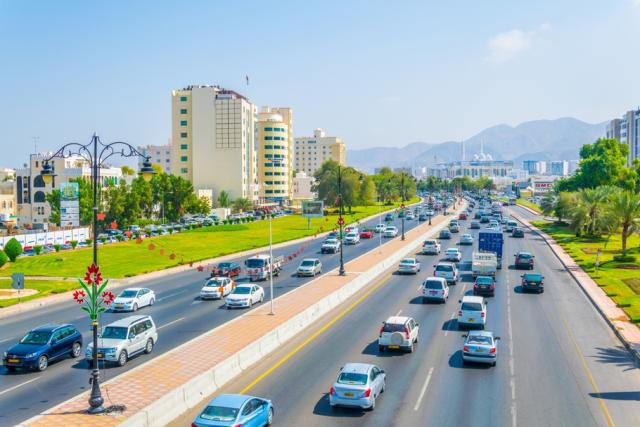
Traffic on the sultan Qaboos street in Muscat, Oman (Source: Shutterstock)
Oman is gearing up its oil and gas production capacity through tapping its heavy oil reserve and tight gas reserves to meet the soaring domestic consumption, especially gas consumption which soared 168% in a 10-year period of 2002 to 2011, according to a report published by Ernst and Young. The study also expects that the Sultanate is likely to divert all its natural gas supply to domestic consumption by 2024.
In addition, the country sits atop heavy oil reservoirs in maturing fields, which require steam, gas or polymer injection to recover crude and to monetize it.
A key project to meet the country’s growing domestic gas consumption, which was commissioned recently, is the Khazzan field in central Oman. The first phase of the project went on stream in September, and was officially inaugurated in November. BP Oman is lead partner in the project with a 60% interest, while Oman Oil Company Exploration & Production holds 40%.
The Khazzan field is characterized by “tight” rock, which requires horizontal drilling and hydraulic fracturing to release trapped gas from depths of up to 5 km below the surface. The gas from Khazzan is will be used as a feedstock to develop the country’s petrochemicals industry as well as in power generation.
The first train has a capacity of 500 MMcf per day of gas, and included a total of 200 wells feeding into a two-train central processing facility. While the second train, which has a similar capacity, will be in operation in early 2018, Salim Al Aufi, Undersecretary at the Omani Ministry of Oil and Gas said. “The local market will have a share of the gas produced from Khazzan gas field. Some quantities will be also exported to be used as feedstock for Oman LNG and Qalhat LNG,” Al Aufi, told local media.
Al Aufi also said that a portion of the production has been also allocated to the Special Economic Zone in Duqm through a gas pipeline that will be completed by the end of 2019, he added. The project is expected to develop circa 7 Tcf of gas and deliver plateau production of 1 Bcf of gas per day and 25,000 bbl/d of gas condensate, delivering long-term gas supply which will benefit Oman over many decades.
The two companies agreed last year to extend licensing agreements, paving the way for the development of a second phase of the giant Khazzan tight gas field, and increasing expected production by 50%.
The Khazzan Phase 2 extension—also known as Ghazeer—is expected to increase full-field production from 1 Bcf/d to 1.5 Bcf/d, the equivalent of around 40% of Oman’s total current gas production. It will mean developing an additional 3.5 Tcf of gas, on top of the 7 Tcf already being developed, and will add more than 380 square miles to the south and west of the current 1,040 square miles in Oman’s Block 61, according to BP. The work will include the construction of a third ‘production train’ at the central processing facility, located 310 miles away from the capital city of Muscat. It also includes the associated gathering and export systems and the drilling of approximately 325 new wells over a 15-year period.
In addition to Khazzan project, Petroleum Development Oman (PDO) and GlassPoint completed the first module (four glasshouses) of the solar Enhanced Oil Recovery (EOR) at the Amal West site. The 1,021 MW facility called Miraah, Arabic for mirror, is set to generate 6,000 tons of steam daily and is the Middle East’s first enhanced oil recovery program to tap into solar energy. The $600 million project will comprise 36 blocks (nine modules) concentrate the sun's rays and generate steam, saving around 5.6 trillion BTU of natural gas annually, which will be deployed towards power generation. The two partners unveiled plans to go ahead a second phase of the project that will include two modules comprised of eight glasshouses, which is expected to be completed by 2019.
Other projects currently Oman’s PDO undertaking include the development of the $1.25 billion Rabab Harweel Integrated Project, which aims to produce 6 million cubic meters a day of sweet gas and 60,000 bbl/d, in addition to the $900 million Yibal Khuff project to deliver 5 MMcm/d of associated gas and 10,000 bbl/d of oil. The two projects are expected to be completed in 2019 and 2020, respectively.
Recommended Reading
From Days to Minutes: AI’s Potential to Transform Energy Sector
2024-11-22 - Despite concerns many might have, AI looks to be the next great tool for the energy industry, experts say.
Fugro’s Remote Capabilities Usher In New Age of Efficiency, Safety
2024-11-19 - Fugro’s remote operations center allows operators to accomplish the same tasks they’ve done on vessels while being on land.
Range Resources Counters M&A Peer Pressure with Drilling Efficiencies
2024-11-14 - Range Resources doesn’t feel the need to give into M&A peer pressure as it focuses on the efficient development of its current asset base, President and CEO Dennis Degner tells Hart Energy.
EnerMech Secures Contract with Major North Sea Operator
2024-11-13 - EnerMech will monitor the condition of the U.K. assets in accordance with safety and operational standards.
2024 E&P Meritorious Engineering Awards for Innovation
2024-11-12 - Hart Energy’s MEA program highlights new products and technologies demonstrating innovations in concept, design and application.
Comments
Add new comment
This conversation is moderated according to Hart Energy community rules. Please read the rules before joining the discussion. If you’re experiencing any technical problems, please contact our customer care team.






